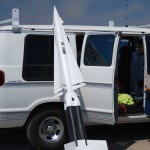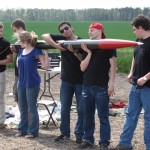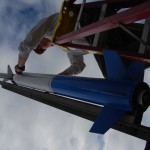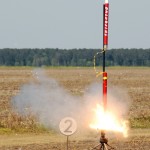For the past few months I have been more lax than usual about writing the monthly launch reports.? Things have been so busy at work and at home that I often forget that I have been to a launch the moment I walk back in the door.? But I still have the flight cards and a few pencil notes I made on Sunday night, so let me try to reconstruct the last two launches at Bayboro.
First, let?s go back to March, to the weekend of the 24th and 25th.? If I recall correctly, the weather on Saturday was distinctly sub-optimal:? mostly cloudy with a low, patchy ceiling and very windy.? The records show that Robert Floyd made at least one TARC qualifying attempt with his White Flash on an F50.? Dennis records that the ?chute came out a little early.? Later on, Jim Livingston used a brief patch of blue sky to put up his AMRAAM on an L1000 for about 4450? of altitude.? All of the recoveries involved a lot of walking and most projects went back in the trucks for another day.
Sunday?s big event was the much-anticipated USLI qualifying flight by Team Tachy-Lycos from North Carolina State University.? Final assembly and prep for this project took all of Saturday and most of the day on Sunday, but finally we were ready to go.?? Their 47 lb, 5.5? diameter rocket, powered by an Aerotech L1420R, flew magnificently when the buttons were finally pushed.? The rocket performed flawlessly, with an altitude of a little more than a mile.? Project leader Clark Moser, advisor Charlie Ogino, and the whole team have a lot to be proud of.? I still haven?t heard whether they were able to make their flight in Alabama last weekend, the weather was threatening all day, I heard.
Another very exciting flight was made by John Elliott with his PML Bulldog on an Ellis Mountain L330.? With the combination of a stiff wind, the forward canard fins, and the very low thrust of the L, the Bulldog was travelling horizontal for the last half of powered flight.? Luckily it fell short of the woods.
Andrew Billin flew his Skyhook twice on E30?s and his Small Endeavor on an H125 for a perfect flight.? Alan Whitmore made 2 flights on Sunday,? an early flight of the Astro*Mollusk VI? ?on a 54mm K motor using a white-flame propellant that went to 7532? and was recovered extremely close before the winds picked up, and a later flight of the GFI on another K motor that took the 14.4 lb rocket to 6350?.? The wind was really moving by this point, and recovery involved a long walk.
Then, two weeks later, we held our biennial Spring WELD event, a 2-day TRA Research event.? The big news for the weekend had to be the successful L2 certification flight made by Scott Schnegelberger with his Thing One flying on a CTI J270G.? The flight to 2200 feet was nearly flawless and the recovery was nice and soft in a hundred acres of chest-high winter wheat.? After abandoning an arduous 1.5 hour search through the fields, he headed back to the launch pads. Scott says he took 10 more steps and walked right into the upper body section lying a dry ditch, recovering everything in perfect condition. Congratulations to Scott on his L2 certification!
(Glorious HD video of Scott’s shakedown flight of Thing One earlier in the day on a CTI I255 Red Lightning, which also found the ditch, is here: http://www.youtube.com/watch?v=-GHmXoWDgPk.)
The flight cards also tell a story of the two weekends, let?s look at the motor summary:
| Size | 3/24 | 3/25 | 4/14 | 4/15 | Total |
| A | 0 | ||||
| B | 0 | ||||
| C | 1 | 1 | |||
| D | 0 | ||||
| E | 2 | 2 | |||
| F | 2 | 2 | |||
| G | 2 | 2 | |||
| H | 1 | 1 | 2 | ||
| I | 1 | 1 | 2 | ||
| J | 5 | 5 | |||
| K | 2 | 2 | 4 | ||
| L | 1 | 2 | 1 | 4 | |
| M | 1 | 1 | 2 | ||
| ? | 3 | 7 | 16 | 3 | 29 |
If you add up all 4 days, it still looks like a single very poorly attended launch.
Dave Morey has rebuilt the Sinister 38, and brought it back out Saturday for another flight.? This one was ?fully loaded? with a central J500G, and airstarting 2 I200W?s, 2 G80T?s and the 2 G53FJ motors to finish off the boost phase.? The multi-colored-propellant flight was perfect, reached 4800?, and was recovered undamaged.? The total installed impulse for these motors was 1827 N.s, so I classified it under the ?K? motors for that day.
Ray Bryant flew four rockets in the H to K range, and if my memory is correct, they all worked very well.? At least one of the rockets carried a High-Def video camera, and I am looking forward to seeing the download(s).
Aiming to continue his legacy of on-field spectacles, Scott Schnegelberger brought out his 2.5″ Thing Two for a rare reappearance and attempted to launch it on a 29mm G106 Skidmark. At ignition, everything separated on the pad and a small grass fire got started. Conjecture on the field was that the motor must not have had a seal between the core and ejection — surprising for a CTI motor. Things got a bit blackened down low, but it will fly again.
John Elliott brought back his wonderful Nike-Hercules and flew it on an M1315W.? Unfortunately, the shock cord got cut by some body part and the back part crashed and the nose cone was carried off into the far northeast corner of the field, where John likes to hang out for at least part of every launch.
One more launch at Bayboro before we take our summer break.
Alan Whitmore, Prefect, Tripoli East NC
- John Elliott’s Nike-Hercules
- Scott Schnegelberger’s L2 Certification flight on his Thing One rocket
- Team Tachy-Lycos from North Carolina State University with their USLI qualifying flight
- Alan Whitmore’s two stage rocket
- Scott Schnegelberger’s Thing Two Pad Ejection






